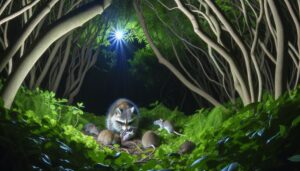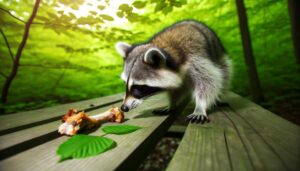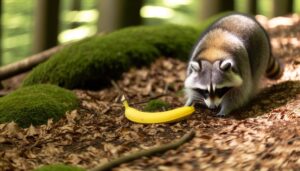How Do Mother Raccoons Feed Their Young?
Mother raccoons initially feed their young by nursing them with nutrient-rich milk, providing essential proteins and antibodies. This sustenance is vital during the first eight weeks of the kits' lives.
As the young raccoons grow, the mother guides them in foraging, teaching them to identify and consume various plant matter, insects, and small animals. Additionally, she imparts hunting techniques such as stalking and pouncing.
Nighttime foraging is common, utilizing the raccoon's heightened sensory perception for efficient food procurement. These feeding practices lay the foundation for the kits' independence and survival.
The intricacies of this maternal care guarantee the young raccoons' success.

Key Takeaways
- Mother raccoons nurse their newborn kits with nutrient-rich milk for about eight weeks.
- The milk provides essential proteins, fats, and antibodies crucial for the kits' immune system.
- Maternal care ensures consistent nourishment and warmth within the den.
- Kits learn foraging skills from their mother, including identifying edible plants and small invertebrates.
- Raccoon mothers guide kits in hunting techniques like stalking and pouncing.
Nursing the Newborn Kits

Mother raccoons demonstrate a high level of maternal care by nursing their newborn kits with nutrient-rich milk, which is crucial for their early development and survival. The milk provided by the mother contains essential proteins, fats, and antibodies that strengthen the immune system of the kits, allowing them to fend off infections and grow robustly.
During the initial weeks postpartum, the mother remains in the den to make sure the kits receive consistent nourishment and warmth. This period of lactation typically lasts for around eight weeks, during which the kits gradually develop physical strength and coordination.
The mother's continuous presence and dedicated feeding regime are crucial in establishing a foundation for the young raccoons' future foraging and survival skills.
Foraging for Food
As the kits grow and develop, the maternal raccoon begins teaching them essential foraging skills necessary for their survival in the wild. This process typically starts when the kits are about eight to ten weeks old.
The mother guides the young in identifying edible plant matter, such as fruits, nuts, and berries, as well as small invertebrates like insects and worms. By observing and mimicking their mother, the kits learn to use their highly sensitive tactile sense to locate food sources.
The raccoon's dexterous front paws play a pivotal role in manipulating objects and uncovering hidden sustenance. This stage is crucial for the kits as it enhances their ability to independently source food, ensuring their nutritional needs are met as they mature.
Teaching Hunting Skills
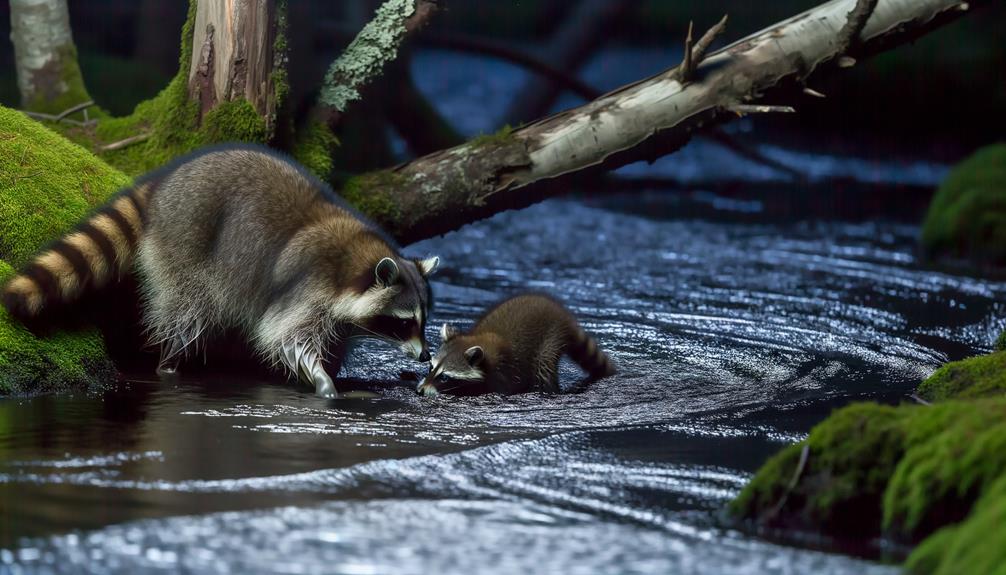
Guiding the kits through the intricacies of hunting, the raccoon imparts necessary predatory skills needed for capturing live prey. This instruction begins when the kits are approximately eight weeks old.
The mother demonstrates techniques such as stalking, pouncing, and handling prey, providing practical, real-world examples. Initially, she may incapacitate smaller prey and allow the kits to practice the final capture. This hands-on learning is vital for developing the kits' motor coordination and timing.
Observational learning plays a significant role, as the young raccoons closely watch and mimic their mother's actions. This method ensures that the kits acquire the ability to hunt effectively, which is essential for their survival and independence in the wild.
Diverse Diet of Raccoons
The dietary habits of raccoons are remarkably diverse, covering a wide array of food sources such as fruits, insects, small mammals, and aquatic organisms. This varied diet guarantees that mother raccoons can meet the extensive nutritional needs of their young, offering essential nutrients for growth and development.
Understanding the specific food types and their nutritional contributions is vital for grasping how raccoons sustain their offspring in various environmental contexts.
Varied Food Sources
Raccoons exhibit a highly varied diet, consuming a wide array of food sources including fruits, insects, small mammals, and aquatic organisms. This dietary diversity is essential for the sustenance of their young, ensuring a balanced intake of essential nutrients.
The primary components of a raccoon's diet can be categorized as follows:
- Fruits: Including berries, apples, and cherries, which provide essential vitamins and sugars.
- Insects: Such as beetles, caterpillars, and grasshoppers, offering protein and fats.
- Small Mammals: Mice, voles, and occasionally young birds, which are rich in protein and fats.
- Aquatic Organisms: Crayfish, frogs, and fish, supplying both protein and essential fatty acids.
This diverse diet enables raccoons to thrive in various habitats, adapting their feeding strategies to available resources.
Nutritional Needs Met
Meeting the diverse nutritional needs of raccoons, their varied diet guarantees the provision of essential vitamins, proteins, fats, and fatty acids necessary for the growth and development of their young. Raccoons are opportunistic feeders, consuming a wide array of food sources to meet these dietary requirements. Their diet typically includes fruits, nuts, insects, small vertebrates, and aquatic organisms, each contributing differently to their nutritional profile.
| Food Source | Nutrient Provided | Example |
|---|---|---|
| Fruits and Vegetables | Vitamins and Fiber | Berries, Apples |
| Insects and Larvae | Proteins | Beetles, Caterpillars |
| Small Vertebrates | Proteins and Fats | Frogs, Mice |
| Aquatic Organisms | Fatty Acids | Fish, Crayfish |
This diverse dietary intake guarantees that the young raccoons receive a balanced nutrition essential for their overall development.
Nighttime Feeding Habits
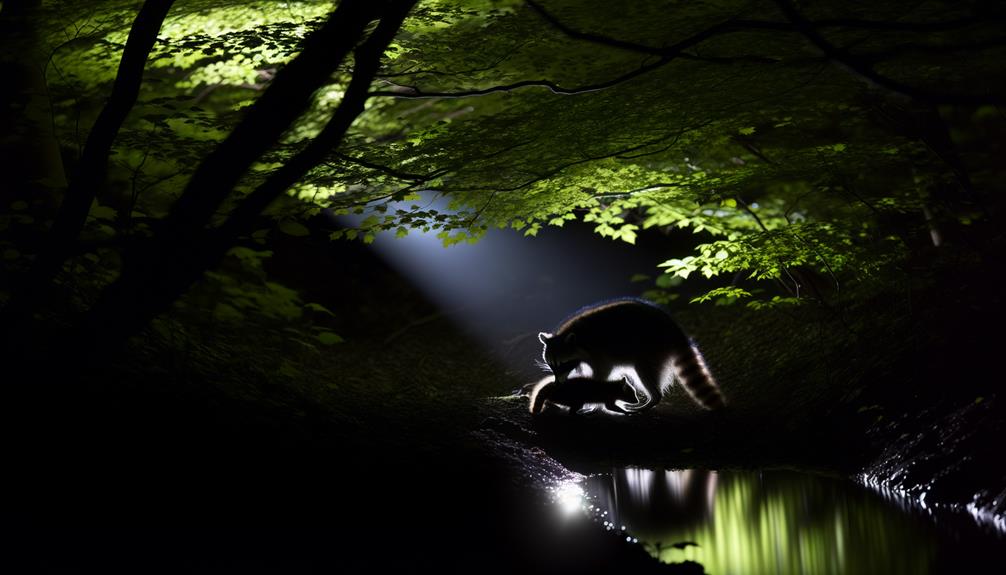
Under the cover of darkness, mother raccoons exhibit specific foraging behaviors to efficiently locate and secure food for their young. Nocturnal by nature, these behaviors are meticulously adapted to the night environment, optimizing their chances of successful foraging.
- Enhanced Sensory Perception: Raccoons possess heightened senses of touch and smell, which are pivotal for detecting food sources in low light conditions.
- Diverse Diet: Their omnivorous diet includes fruits, nuts, insects, small mammals, and even aquatic organisms, ensuring varied nutritional intake.
- Strategic Foraging Routes: Mothers follow established routes with known food sources to maximize efficiency and minimize energy expenditure.
- Stealth and Caution: They move quietly to avoid predators and human interaction, ensuring safe return to their offspring.
These behaviors exemplify their adaptability and survival strategies.
Weaning Process
The weaning process in mother raccoons typically begins when the kits are around 8 to 10 weeks old, marking an important shift from maternal milk to solid food. During this pivotal phase, the mother gradually introduces her young to a diet consisting of fruits, nuts, insects, and small vertebrates.
Initially, the kits may struggle with consuming solid foods, necessitating the mother's guidance and patience. She often brings food to the den and demonstrates foraging techniques. This period of dietary change is critical, as it equips the kits with the necessary skills for independent survival.
Feeding Safety Strategies
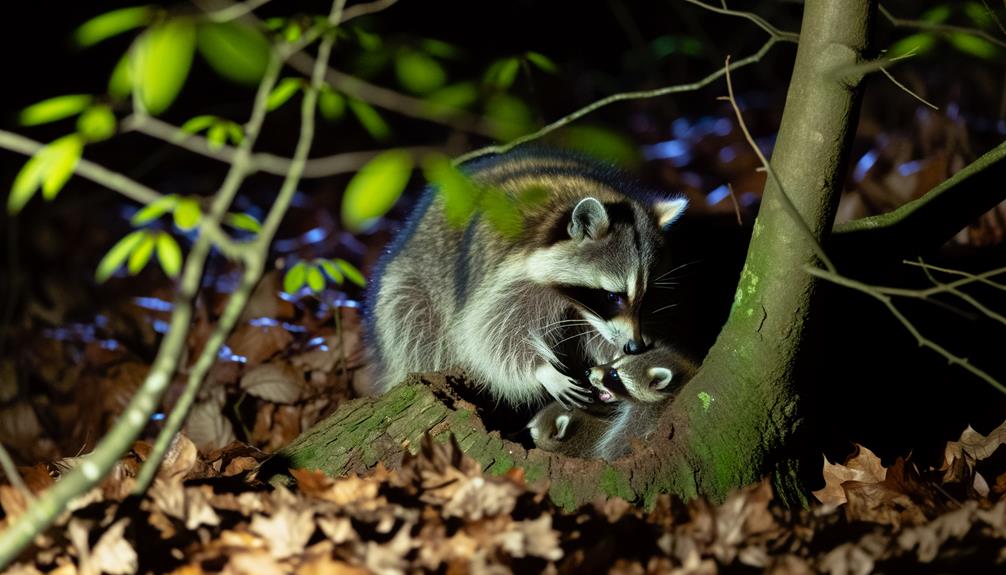
Mother raccoons employ various feeding safety strategies to protect their young. These include nighttime foraging behavior, which reduces the risk of encountering predators. Additionally, the selection of nesting sites is pivotal. These locations must provide both food accessibility and security.
Predatory threat avoidance is further enhanced through vigilant behavior and the use of natural cover during feeding excursions.
Nighttime Foraging Behavior
Utilizing the cover of darkness, raccoons employ a variety of feeding safety strategies to protect themselves and their young from potential predators. Their nocturnal behavior is pivotal in minimizing risks.
Key strategies include:
- Silent Movement: Raccoons move stealthily to avoid detection by predators, ensuring they do not attract unwanted attention.
- Diversified Diet: They consume a wide range of food sources, reducing the need to venture far from their nesting sites, thereby limiting exposure.
- Use of Cover: Raccoons forage in areas with dense vegetation or urban structures that provide ample hiding spots.
- Vigilant Foraging: Constantly scanning their surroundings, raccoons remain alert to any signs of danger, ready to retreat quickly if necessary.
These strategies collectively enhance their survival and that of their offspring.
Nesting Site Selection
Central to the feeding safety strategies of raccoons, nesting site selection involves choosing locations that offer best protection and resource availability. Mother raccoons meticulously seek out dens that provide shelter from environmental stressors and potential predators. Preferred sites often include hollow trees, abandoned burrows, and man-made structures such as attics or barns.
These locations offer both seclusion and proximity to food sources. The selected nesting sites are generally elevated or otherwise difficult for larger predators to access. Additionally, raccoons exhibit adaptability, adjusting their nesting choices based on the availability of resources and changes in their environment.
This strategic selection ensures that mother raccoons can safely rear their young, minimizing risks during the critical feeding and developmental stages.
Predatory Threat Avoidance
Strategically selected nesting sites not only provide shelter but also play a pivotal role in minimizing predatory threats during feeding times.
Mother raccoons employ several safety strategies to safeguard the wellbeing of their young.
- Elevated Locations: Nesting in trees or high structures reduces the risk of ground-based predators.
- Camouflage: Utilizing natural foliage and debris for concealment helps blend the nest into the environment.
- Nocturnal Feeding: Feeding primarily at night capitalizes on reduced visibility, lowering the chances of predation.
- Frequent Relocation: Periodically moving the nest to new locations can prevent predators from tracking the family.
These strategies collectively enhance the survival rates of raccoon offspring by reducing the risks associated with predatory threats during vulnerable feeding periods.
Seasonal Food Sources
Seasonal food sources for mother raccoons vary greatly throughout the year, influencing their feeding strategies and nutritional intake.
During spring and summer, raccoons primarily consume insects, fruits, and small vertebrates, taking advantage of the abundance of these resources.
In autumn, their diet shifts towards acorns, nuts, and other mast, allowing them to build fat reserves essential for the colder months.
Winter presents a challenge, as food becomes scarce; raccoons may rely on scavenging and stored food sources such as cached nuts.
This seasonal adaptability ensures that mother raccoons can adequately nourish their young, promoting growth and development.
Understanding these dietary patterns is essential for comprehending raccoon ecology and their survival strategies across different environmental conditions.
Role of Siblings
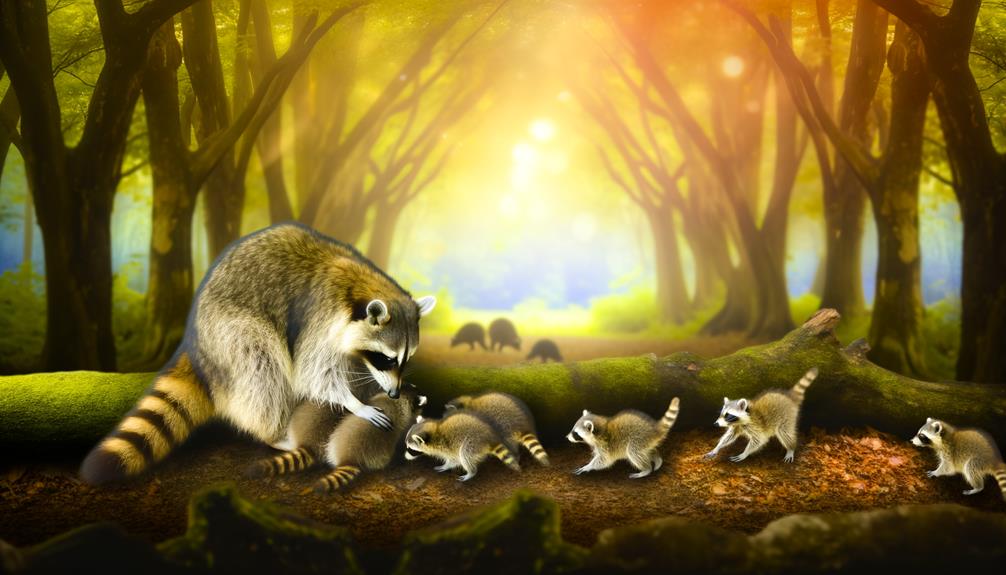
Siblings play a crucial role in the development and social dynamics of young raccoons, influencing their foraging behaviors, social skills, and overall survival. The presence of siblings provides essential interaction opportunities that shape various aspects of their growth.
Key roles include:
- Foraging Efficiency: Siblings mimic each other's foraging strategies, leading to improved food-gathering skills.
- Social Learning: Interaction among siblings facilitates learning of social hierarchies and cooperative behaviors.
- Play Behavior: Engaging in play fights and games helps develop physical coordination and problem-solving skills.
- Stress Reduction: Siblings provide emotional support, reducing stress and increasing resilience in challenging environments.
Understanding these dynamics underscores the importance of sibling interactions in the early stages of raccoon life.
Human Interaction Impact
Human interaction greatly affects mother raccoons' ability to feed their young by disrupting natural feeding patterns and fostering dependency on human-provided food sources.
This dependency not only alters their diet but also increases their risk of harm through frequent encounters with vehicles and potential human conflict.
Consequently, such interactions can have profound implications for the health and survival of raccoon populations.
Disruption of Feeding Patterns
Interactions with humans can disrupt the feeding patterns of mother raccoons, leading to adverse effects on their offspring's development and survival. These disruptions can stem from various human activities and environmental modifications that interfere with natural behaviors.
Key factors include:
- Habitat Encroachment: Urban development reduces the availability of natural foraging areas, forcing raccoons to travel further to find food.
- Nocturnal Disturbances: Increased nighttime human activity can cause stress and reduce the time available for mothers to forage.
- Direct Interference: Human interventions, such as relocating raccoons or disturbing dens, can separate mothers from their young.
- Chemical Exposure: Pesticides and pollutants in urban areas may contaminate food sources, posing health risks to both mothers and their offspring.
Understanding these factors is essential for mitigating human impact on raccoon populations.
Dependency on Human Food
The disruption of natural feeding patterns is further exacerbated by the increasing dependency of mother raccoons on human food sources, which alters their foraging behavior and nutritional intake.
Urban expansion and human encroachment into raccoon habitats have led these animals to exploit easily accessible food waste. This shift results in a diet that is often higher in fats and carbohydrates, contrasting sharply with their natural diet of fruits, nuts, and small animals.
Consequently, the nutritional composition of the milk provided to their young is altered, potentially affecting the development and health of the offspring. Such reliance on anthropogenic food sources underscores the significant role human activity plays in transforming wildlife feeding habits and the broader ecological implications.
Increased Risk of Harm
Heightened human interaction with mother raccoons greatly raises the risk of harm to both the animals and their young through potential encounters, disease transmission, and habitat disruption. Such interactions can lead to detrimental outcomes including injury, stress, and mortality.
Key factors influencing these risks include:
- Physical Encounters: Increased chances of aggressive encounters between raccoons and humans, potentially leading to injuries.
- Disease Transmission: Elevated risk of zoonotic diseases such as rabies and leptospirosis spreading between raccoons and humans.
- Habitat Disruption: Human activities can lead to habitat fragmentation, reducing the availability of safe nesting sites.
- Behavioral Changes: Frequent human presence can alter raccoon behavior, leading to dependency on anthropogenic food sources and decreased survival skills in the wild.
Understanding these risks is essential for mitigating negative impacts on raccoon populations.
Conclusion
Mother raccoons exhibit complex feeding behaviors to guarantee the survival of their offspring. Remarkably, raccoons possess a diverse diet, consuming over 100 different types of food items. This adaptability aids in their resilience across various environments.
From nursing newborn kits to teaching hunting skills and utilizing seasonal food sources, mother raccoons employ strategic methods to nourish their young. Understanding these behaviors provides insight into the species' ecological success and the impact of human interactions on their feeding patterns.


